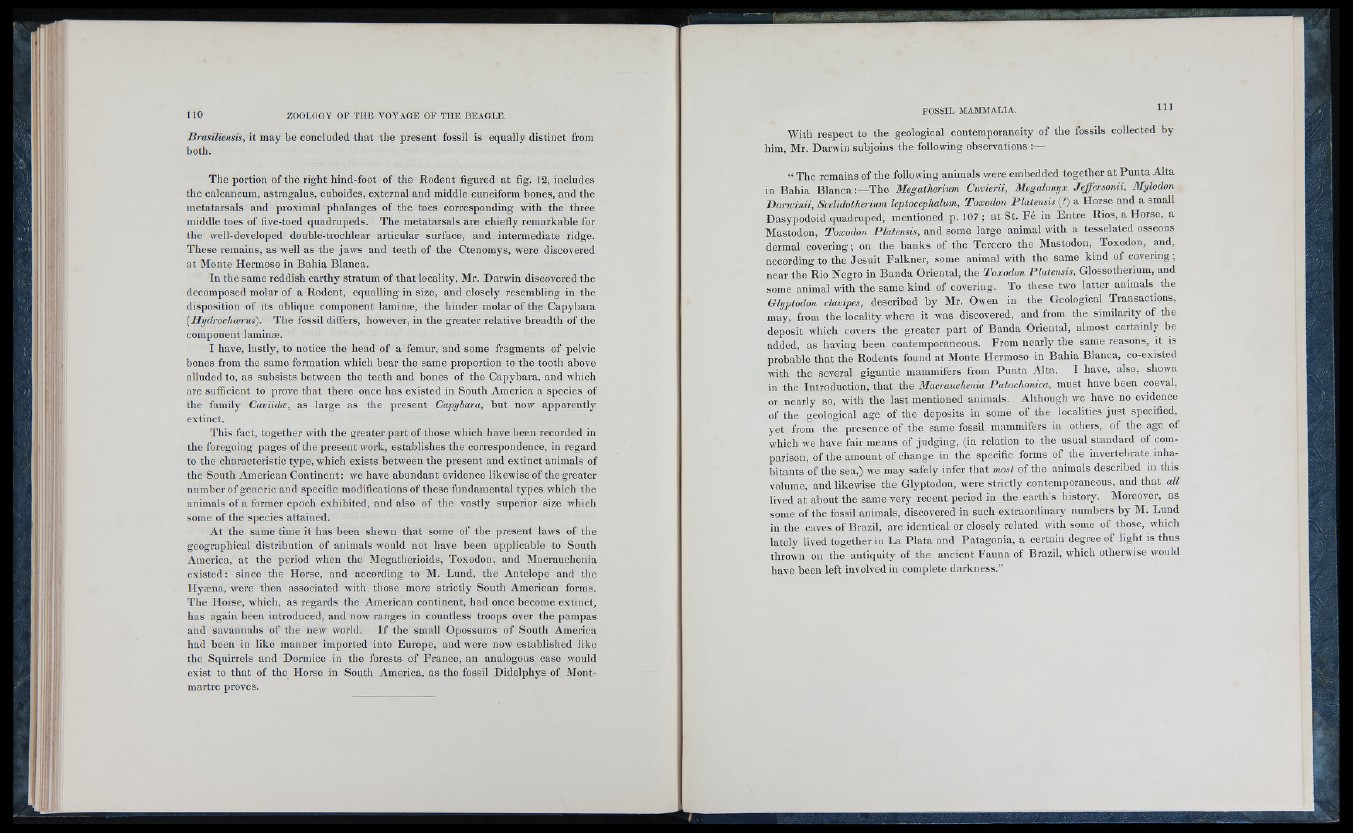
pi'
Brasiliensis, it may be concluded that the present fossil is equally distinct from
both.
The portion o f the right hind-foot o f the Rodent figured at fig. 12, includes
the calcaneum, astragalus, cuboides, external and middle cuneiform bones, and the
metatarsals and proximal phalanges o f the toes corresponding with the three
middle toes o f five-toed quadrupeds. The metatarsals are chiefly remarkable for
the well-developed double-trochlear articular surface, and intermediate ridge.
Th ese remains, as well as the jaw s and teeth o f the Ctenomys, were discovered
at Monte Hermoso in Bahia Blanca.
In the same reddish earthy stratum o f that locality, Mr. Darwin discovered the
decomposed molar o f a Rodent, equalling in size, and c lose ly resembling in the
disposition o f its oblique component laminæ, the hinder molar o f the Capybara
{Hydrochærus). The fossil differs, however, in the greater relative breadth o f the
component laminæ.
I have, la stly , to notice the head o f a femur, and some fragments o f pelvic
bones from the same formation which bear the same proportion to the tooth above
alluded to, as subsists between the teeth and bones o f the Capybara, and which
are sufficient to prove that there once has ex isted in South America a spe cie s o f
the family Caviidoe, as large as the present Capybara, but now apparently
extinct.
This fact, together with the greater part of those which have been recorded in
the foregoing pages o f the present work, establishes the correspondence, in regard
to the characteristic type, which ex ists between the present and extinct animals o f
tlie South American Continent: we have abundant evidence likewise o f the greater
number o f generic and specific modifications of these fundamental types which the
animals o f a former epoch exhibited, and also o f the va stly superior size which
some o f the spe cie s attained.
At the same time it has been shewn that some o f the present laws of tlie
geographical distribution o f animals would not have been applicable to South
America, at the period when the Megatherioids, Toxodon, and Macrauchenia
existed : since the Horse, and according to M. Lund, the Antelope and the
Hyæna, were then associated with those more strictly South American forms.
The Horse, which, as regards the American continent, had once become extinct,
has again been introduced, and now ranges in countless troops over the ¡campas
and savannahs o f the new world. I f the small Opossums o f South America
had been in like manner imported into Europe, and were now established like
the Squirrels and Dormice in the forests of France, an analogous case would
ex ist to that o f the Horse in South America, as the fossil D idelphys o f Montmartre
proves.
With respect to the geological contemporaneity o f the fossils collected by
him, Mr. Darwin subjoins the following observations
“ The remains o f the following animals were embedded together at Pu n ta A lta
in Bahia B la n ca :—Th e Megatherium Cuvierii, Megalonyx Jeffersonii, Mylodon
Da riv in ii, Scelidotherium leptocephalwn, Toxodon Platensis {?) a Horse and a small
Dasypodoid quadruped, mentioned p. 107; at St. F 6 in Entre Rios, a Horse, a
Mastodon, Toxodon Platensis, and some large animal with a tesselated osseous
dermal co v e rin g ; on the banks o f the Tercero the Mastodon, Toxodon, and,
according to the Jesu it Falkner, some animal with the same kind of covering;
near the Rio Negro in Banda Oriental, the Toxodon Platensis, Glossotherium, and
some animal with the same kind o f covering. To these two latter animals the
Glyptodon clavipes, described b y Mr. Owen in the Geological Transactions,
may, from the locality where it was discovered, and from the similarity o f the
deposit which covers the greater part o f Banda Oriental, almost certainly be
added, as having been contemporaneous. From nearly the same reasons, it is
probable that the Rodents found at Monte Hermoso in Bah ia Blanca, co-existed
with the several gigantic maminifers from Pu n ta Alta. I have, also, shown
in the Introduction, that the Macrauchenia Patachonica, must have been coeval,
or nearly so, with the last mentioned animals. Although we have no evidence
o f the geological age o f the deposits in some o f the localities ju st specified,
y e t from the presence o f the same fossil mainmifers in others, o f the age of
which we have fair means o f judging, (in relation to the usual standard o f comparison.
o f the amount of change in the specific forms o f the invertebrate inhabitants
o f the sea,) we may safely infer that most o f the animals described in this
volume, and likewise the Glyptodon, were strictly contemporaneous, and that all
lived at about the same very recent period in the earth's history. Moreover, as
some o f the fossil animals, discovered in such extraordinary numbers by M. Lund
in the caves o f Brazil, are identical or closely related with some o f those, which
la te ly lived together in La P la ta and Patagonia, a certain degree o f light is thus
thrown on the antiquity o f the ancient Fauna o f Brazil, which otherwise would
have been le ft involved in complete darkness.”